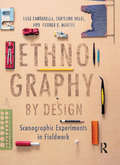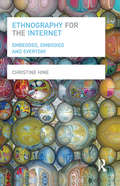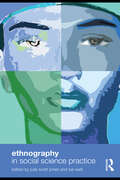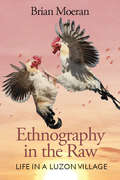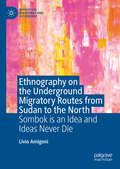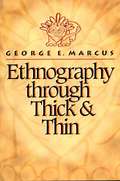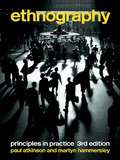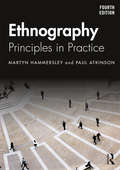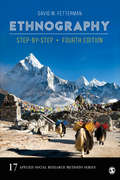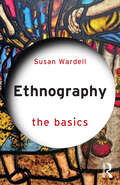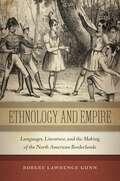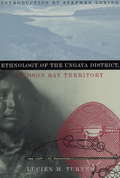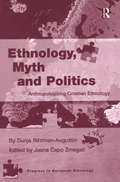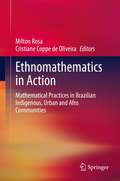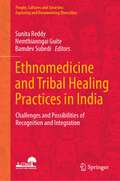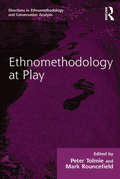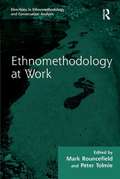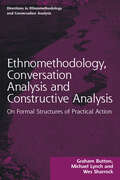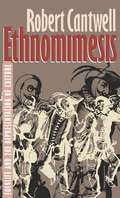- Table View
- List View
Ethnography by Design: Scenographic Experiments in Fieldwork (Criminal Practice Ser.)
by George E. Marcus Christine Hegel Luke CantarellaEthnography by Design, unlike many investigations into how ethnography can be done, focuses on the benefits of sustained collaboration across projects to ethnographic enquiry, and the possibilities of experimental co-design as part of field research. The book translates specifically scenic design practices, which include processes like speculation, materialization, and iteration, and applies them to ethnographic inquiry, emphasizing both the value of design studio processes and "designed" field encounters. The authors make it clear that design studio practices allow ethnographers to ask and develop very different questions within their own and others' research and thus, design also offers a framework for shaping the conditions of encounter in ways that make anthropological suppositions tangible and visually apparent. Written by two anthropologists and a designer, and based on their experience of their collective endeavours during three projects, Luke Cantarella, Christine Hegel, and George E. Marcus examine their works as a way to continue a broader inquiry into what the practice of ethnography can be in the twenty-first century, and how any project distinctively moves beyond standard perspectives through its crafted modes of participation and engagement.
Ethnography for the Internet: Embedded, Embodied and Everyday (Criminal Practice Ser.)
by Christine HineThe internet has become embedded into our daily lives, no longer an esoteric phenomenon, but instead an unremarkable way of carrying out our interactions with one another. Online and offline are interwoven in everyday experience. Using the internet has become accepted as a way of being present in the world, rather than a means of accessing some discrete virtual domain. Ethnographers of these contemporary Internet-infused societies consequently find themselves facing serious methodological dilemmas: where should they go, what should they do there and how can they acquire robust knowledge about what people do in, through and with the internet? This book presents an overview of the challenges faced by ethnographers who wish to understand activities that involve the internet. Suitable for both new and experienced ethnographers, it explores both methodological principles and practical strategies for coming to terms with the definition of field sites, the connections between online and offline and the changing nature of embodied experience. Examples are drawn from a wide range of settings, including ethnographies of scientific institutions, television, social media and locally based gift-giving networks.
Ethnography in Social Science Practice
by Sal Watt Julie Scott-JonesEthnography in Social Science Practice explores ethnography’s increasing use across the social sciences, beyond its traditional bases in social anthropology and sociology. It explores the disciplinary roots of ethnographic research within social anthropology, and contextualizes it within both field and disciplinary settings. The book is of two parts: Part one places ethnography as a methodology in its historical, ethical and disciplinary context, and also discusses the increasing popularity of ethnography across the social sciences. Part two explores the stages of ethnographic research via a selection of multidisciplinary case studies. A number of key questions are explored: What exactly is ethnographic research and what makes it different from other qualitative approaches? Why did ethnography emerge within one social science discipline and not others? Why did its adoption across the social sciences prove problematic? What are the methodological advantages and disadvantages of doing ethnographic research? Why are ethnographers so concerned by issues of ethics, politics, representation and power? What does ethnography look like within different social science disciplines? The book is aimed at social science students at both undergraduate and postgraduate level and each chapter has pedagogic features, including reflective activities and suggested further readings for students.
Ethnography in Today's World
by Roger SanjekIn Ethnography in Today's World, Roger Sanjek examines the genre and practice of ethnography from a historical perspective, from its nineteenth-century beginnings and early twentieth-century consolidation, through political reorientations during the 1960s and the impact of feminism and postmodernism in later decades, to its current outlook in an increasingly urban world. Drawing on a career of ethnographic research across Brazil, Ghana, New York City, and with the Gray Panthers, Sanjek probes politics and rituals in multiethnic New York, the dynamics of activist meetings, human migration through the ages, and shifting conceptions of race in the United States. He interrogates well-known works from Boas, Whyte, Fabian, Geertz, Marcus, and Clifford, as well as less celebrated researchers, addressing methodological concerns from ethnographers' reliance on assistants in the formative days of the discipline to contemporary comparative issues and fieldwork and writing strategies.Ethnography in Today's World contributes to our understanding of culture and society in an age of globalization. These provocative examinations of the value of ethnographic research challenge conventional views as to how ethnographic fieldwork is and can be conceived, conducted, contextualized, and communicated to academic audiences and the twenty-first-century public.
Ethnography in the Raw: Life in a Luzon Village
by Brian MoeranEthnography in the Raw describes the author’s encounters with the Philippine family into which he has married, his wife’s friends and acquaintances, and their lives in a remote rural village in the rice basin of Luzon, about 130 miles northeast of Manila. The book links detailed descriptions of his Philippine family with cultural practices such as circumcision, marriage and cockfights combined with theoretical musings on the concepts of sacrifice, social exchange, patron-client relations, food, and religious symbolism. It is both anthropological fieldwork ‘in the raw,’ and an incisive analysis of contemporary Philippine society and culture.
Ethnography in the Raw: Life in a Luzon Village
by Brian MoeranEthnography in the Raw describes the author’s encounters with the Philippine family into which he has married, his wife’s friends and acquaintances, and their lives in a remote rural village in the rice basin of Luzon, about 130 miles northeast of Manila. The book links detailed descriptions of his Philippine family with cultural practices such as circumcision, marriage and cockfights combined with theoretical musings on the concepts of sacrifice, social exchange, patron-client relations, food, and religious symbolism. It is both anthropological fieldwork ‘in the raw,’ and an incisive analysis of contemporary Philippine society and culture.
Ethnography on the Underground Migratory Routes from Sudan to the North: Sombok Is an Idea and Ideas Never Die (Migration, Diasporas and Citizenship)
by Livio AmigoniThis book uses an ethnography of the migratory route from Sudan to the EU to understand how undocumented migration experiences take place and breed underground forms of mobilities and survival strategies. It pays particular attention to the production, circulation and resilience of migratory knowledge in transnational networks and how those produce and sustain specific mobility practices. The related research questions focus on: how and which narratives and popular imaginations circulate and foster high-risk journeys towards Europe, referred to as sombok; understanding how these kind of journeys are interpreted and framed according to gender, religion and family traditions; discerning how border regimes produce specific migration careers, decision making processes and forms of resistance and cooperation with other actors; how the figure of the smuggler is framed by people on the move and how one group of smugglers interpret their activities at the Ventimiglia border; and how the practices of homing on the move and solidarity housing experiences take place and prop underground routes. This book will be of interest to scholars of migration.
Ethnography through Thick and Thin
by George E. MarcusIn the 1980s, George Marcus spearheaded a major critique of cultural anthropology, expressed most clearly in the landmark book Writing Culture, which he coedited with James Clifford. Ethnography through Thick and Thin updates and advances that critique for the late 1990s. Marcus presents a series of penetrating and provocative essays on the changes that continue to sweep across anthropology. He examines, in particular, how the discipline's central practice of ethnography has been changed by "multi-sited" approaches to anthropology and how new research patterns are transforming anthropologists' careers. Marcus rejects the view, often expressed, that these changes are undermining anthropology. The combination of traditional ethnography with scholarly experimentation, he argues, will only make the discipline more lively and diverse.The book is divided into three main parts. In the first, Marcus shows how ethnographers' tradition of defining fieldwork in terms of peoples and places is now being challenged by the need to study culture by exploring connections, parallels, and contrasts among a variety of often seemingly incommensurate sites. The second part illustrates this emergent multi-sited condition of research by reflecting it in some of Marcus's own past research on Tongan elites and dynastic American fortunes. In the final section, which includes the previously unpublished essay "Sticking with Ethnography through Thick and Thin," Marcus examines the evolving professional culture of anthropology and the predicaments of its new scholars. He shows how students have increasingly been drawn to the field as much by such powerful interdisciplinary movements as feminism, postcolonial studies, and cultural studies as by anthropology's own traditions. He also considers the impact of demographic changes within the discipline--in particular the fact that anthropologists are no longer almost exclusively Euro-Americans studying non-Euro-Americans. These changes raise new issues about the identities of anthropologists in relation to those they study, and indeed, about what is to define standards of ethnographic scholarship.Filled with keen and highly illuminating observations, Ethnography through Thick and Thin will stimulate fresh debate about the past, present, and future of a discipline undergoing profound transformations.
Ethnography, Superdiversity and Linguistic Landscapes
by Jan BlommaertSuperdiversity has rendered familiar places, groups and practices extraordinarily complex, and the traditional tools of analysis need rethinking. In this book, Jan Blommaert investigates his own neighbourhood in Antwerp, Belgium, from a complexity perspective. Using an innovative approach to linguistic landscaping, he demonstrates how multilingual signs can be read as chronicles documenting the complex histories of a place. The book can be read in many ways: as a theoretical and methodological contribution to the study of linguistic landscape; as one of the first monographs which addresses the sociolinguistics of superdiversity; or as a revision of some of the fundamental assumptions of social science through the use of chaos and complexity theory as an inspiration for understanding the structures of contemporary social life.
Ethnography: A Theoretically Oriented Practice
by Vincenzo Matera Angela BiscaldiThis volume presents both a historical exploration of ethnography and a thematic discussion of major trends that, over different periods, have oriented and re-oriented research practice. As it overviews ethnography from different geographic and thematic perspectives, it further explores new lines of ethnographic research, including as feminist ethnography and visual research, that uncover non-traditional routes to anthropological knowledge.As the great ethnographer E. E. Evans-Pritchard wrote, “Anyone who is not a complete idiot can do fieldwork… but will [his contribution] be to theoretical, or just to factual knowledge?” As Evans-Pritchard highlights and as this book argues, successful ethnography must be connected to a sophisticated theoretical reflection rooted in social and cultural anthropology.
Ethnography: Principles in Practice
by Paul Atkinson Martyn HammersleyNow in its third edition, this leading introduction to ethnography has been thoroughly updated and substantially rewritten. It offers a systematic introduction to ethnographic principles and practice. New material covers the use of visual and virtual research methods, hypermedia software and the issue of ethical regulation. There is also a new prologue and epilogue. The authors argue that ethnography is best understood as a reflexive process. What this means is that we must recognize that social research is part of the world that it studies. From an outline of the principle of reflexivity the authors go on to discuss and exemplify main features of ethnographic work, including: the selection and sampling of cases the problems of access observation and interviewing recording and filing data the process of data analysis and writing research reports. Throughout, the discussion draws on a wide range of illustrative material from classic and more recent studies within a global context. The new edition of this popular textbook will be an indispensable resource for students and researchers utilizing social research methods in the social sciences and cultural studies.
Ethnography: Principles in Practice
by Paul Atkinson Martyn HammersleyNow in its fourth edition, this leading introduction to ethnography has been thoroughly updated and substantially rewritten. The volume offers a systematic introduction to ethnographic principles and practice, and includes a new chapter on ‘Ethnography in the digital world’. The authors argue that ethnography is best understood as a reflexive process. This requires recognition that social research is part of the world that it studies, and demands that researchers reflect on how they shape both data and analysis. Starting in Chapter 1 with an outline of the principle of reflexivity, against the background of competing research philosophies, the authors go on to discuss the main features of ethnographic work, including: the selection and sampling of cases the problem of access field relations and observation interviewing the use of documents recording and organizing data the process of data analysis and writing research reports. There is also consideration of the ethical issues involved in ethnographic research. Throughout, the discussion draws on a wide range of illustrative material from classic and more recent studies, within a global context. The new edition of this popular textbook will be an indispensable resource for undergraduate and postgraduate students, and for all researchers using ethnographic methods in the social sciences and the humanities.
Ethnography: Step-by-Step (3rd Edition) (Applied Social Research Methods Series #Vol. 17)
by David Fetterman"Emphasis on the use of theory as a guide is excellent and cannot be stressed enough among students . . . . Ethical standards are comprehensively addressed. Any doubts the reader may have had are dispelled by the author's compelling arguments and illustrative examples."—Patricia I. Documét, University of Pittsburgh"The text has included most topics that I cover in my seminar with doctoral students and some that believe they will find helpful. One of those items an actual approach to writing a research proposal and distinctions between action research, policy research, and investigatory kinds of explorations."—Barbara K. Curry, University of DelawareThe Third Edition of Ethnography: Step-by-Step guides readers in collecting and making sense of large amounts of ethnographic data. It also offers current discussion about the use of technology in the pursuit of ethnography. Fundamentally, however, it demonstrates how ethnography is more than a methodological approach. For David M. Fetterman, ethnography is a way of life.
Ethnography: Step-by-Step (Applied Social Research Methods #17)
by David FettermanDavid M. Fetterman captures the ethnographic imagination with the Fourth Edition of his popular text, Ethnography: Step-by-Step. He shares new case examples of his work to highlight the illuminating power of reflexivity and theory. The new edition expands the discussion of critical concepts such as culture, contextualization, emic and etic distinctions, and symbols. The book provides insights into the use of technology in ethnography from qualitative data analysis software to data visualization, and Questions for Reflection have been added to the end of each chapter. Fetterman is a seasoned educator, evidenced by both the clarity of his thinking and the simplicity of his writing.
Ethnography: Step-by-Step (Applied Social Research Methods #17)
by David FettermanDavid M. Fetterman captures the ethnographic imagination with the Fourth Edition of his popular text, Ethnography: Step-by-Step. He shares new case examples of his work to highlight the illuminating power of reflexivity and theory. The new edition expands the discussion of critical concepts such as culture, contextualization, emic and etic distinctions, and symbols. The book provides insights into the use of technology in ethnography from qualitative data analysis software to data visualization, and Questions for Reflection have been added to the end of each chapter. Fetterman is a seasoned educator, evidenced by both the clarity of his thinking and the simplicity of his writing.
Ethnography: The Basics (The Basics)
by Susan WardellEthnography: The Basics introduces a broad and beginner audience to ethnography as a research methodology with diverse applications. By using everyday language and developing a warm and inclusive tone, the book provides an accessible entry point to the topic.It offers a picture of the practice of ethnography that is both human and humane, tackling some of the practical barriers, ethical complexities, and lived experiences in an honest and straightforward way. Organised into eight chapters, the book provides a comprehensive overview of the unique purpose, value, and scope of ethnography, as well as a practical guide as to what the practice of ethnographic research involves, such as steps for designing research, gathering data, and analysing and presenting findings.Without relying on assumed familiarity with or interest in discipline-specific histories and frameworks, Ethnography: The Basics combines clear structure, plain language, and thoughtfully selected examples and stories to welcome students into this interesting and valuable subject. The book will also be of great interest to academics and professionals who wish to supplement their ethnographic knowledge.
Ethnology and Empire: Languages, Literature, and the Making of the North American Borderlands (America and the Long 19th Century #6)
by Robert Lawrence GunnWinner, The Early American Literature Book PrizeEthnology and Empire tells stories about words and ideas, and ideas aboutwords that developed in concert with shifting conceptions about Native peoplesand western spaces in the nineteenth-century United States. Contextualizing theemergence of Native American linguistics as both a professionalized researchdiscipline and as popular literary concern of American culture prior to theU.S.-Mexico War, Robert Lawrence Gunn reveals the manner inwhich relays between the developing research practices of ethnology, works offiction, autobiography, travel narratives, Native oratory, and sign languagesgave imaginative shape to imperial activity in the western borderlands. In literary andperformative settings that range from the U.S./Mexico borderlands to the GreatLakes region of Tecumseh’s Pan-Indian Confederacy and the hallowed halls oflearned societies in New York and Philadelphia, Ethnology and Empire modelsan interdisciplinary approach to networks of peoples, spaces, and communicationpractices that transformed the boundaries of U.S. empire through atransnational and scientific archive. Emphasizing the culturally transformativeimpacts western expansionism and Indian Removal, Ethnology and Empire reimaginesU.S. literary and cultural production for future conceptions of hemisphericAmerican literatures.
Ethnology of the Ungava District, Hudson Bay Territory
by Lucien M. Turner Stephen LoringLucien Turner arrived at the present-day community of Kuujjuaq on the northern Quebec-Labrador peninsula in 1882. As with his earlier long-term appointments in Alaska, he primarily conducted meteorological, atmospheric, and tidal observations for the U.S. Army's Signal Corps. But he also developed a meaningful rapport with the Innu and Inuit, spending his free time studying and recording not only their material culture--including clothing, dwellings, weapons, and tools--but also their lifeways, language, and stories. His images of these people and their camps are among the earliest examples of photography of the Arctic. As Stephen Loring Notes in the introduction, "With few exceptions--Inuit shamanistic paraphernalia and Innu hunting charms--the majority of the materials Turner collected were artifacts and clothing used in day-to-day activities. The passage of time and the miracle of conservation have transformed these ethnographic minutiae, these objects and materials of relatively minor significance on the past, into treasured cultural icons." Especially notable for Lucien Turner's descriptions of nineteenth-century Native material culture, Ethnology of the Ungava District, Hudson Bay Territory was originally published in 1894 as part of the Smithsonian's Annual Report of the Bureau of American Ethnology series--often considered to mark the beginning of American anthropological studies. This reissue ensures that Turner's work continues to be a classic introduction to the culture of the Innu and Inuit people of northern Quebec and Labrador.
Ethnology, Myth and Politics: Anthropologizing Croatian Ethnology (Progress in European Ethnology)
by Dunja Rihtman-Augustin Jasna Capo ZmegacThe book offers a critical overview of Croatian ethnology written by the most prominent Croatian ethnologist/ anthropologist in the second half of the 20th century - Dunja Rihtman-Augustin (recently deceased). She was the first Croatian ethnologist to break with the long established tradition of diffusionist (culture area) studies of her contemporaries and start to anthropologize Croatian ethnology. This book, compiled and completed by Jasna Capo Zmegac, highlights some crucial remarks with regard to the relationship between ethnology and politics. They are formulated as a series of research questions and problems, including: the role of folk culture as mythomoteur, cannonization of the folk culture, nationalization of the peasants in the 19th century and the role of ethnology. This vividly written text offers an exceptional insight into Croatian ethnological developments in the past century, as well as into crucial ruptures in Croatian society which have had important repercussions on ethnological discipline.
Ethnomathematics in Action: Mathematical Practices in Brazilian Indigenous, Urban and Afro Communities
by Milton Rosa Cristiane Coppe de OliveiraThis book presents a collection of ethnomathematical studies of diverse mathematical practices in Afro-Brazilian, indigenous, rural and urban communities in Brazil. Ethnomathematics as a research program aims to investigate the interrelationships of local mathematical knowledge sources with broader universal forms of mathematics to understand ideas, procedures, and practices found in distinct cultural groups. Based on this approach, the studies brought together in this volume show how this research program is applied and practiced in a culturally diverse country such as Brazil, where African, indigenous and European cultures have generated different forms of mathematical practice. These studies present ethnomathematics in action, as a tool to connect the study of mathematics with the students’ real life experiences, foster critical thinking and develop a mathematics curriculum which incorporates contributions from different cultural groups to enrich mathematical knowledge. By doing so, this volume shows how ethnomathematics can contribute in practice to the development of a decolonial mathematics education. Ethnomathematics in Action: Mathematical Practices in Brazilian Indigenous, Urban and Afro Communities will be of interest to educators and educational researchers looking for innovative approaches to develop a more inclusive, democratic, critical, multicultural and multiethnic mathematics education.
Ethnomedicine and Tribal Healing Practices in India: Challenges and Possibilities of Recognition and Integration (People, Cultures and Societies: Exploring and Documenting Diversities)
by Sunita Reddy Nemthianngai Guite Bamdev SubediThis book examines various aspects of ethnomedicine and tribal healing practices, including its importance for inclusion and integration from a health systems perspective. Tribal healing practices is an under-studied component in healthcare system, health policy and health systems research. The book consists of original research papers based on empirical studies done by anthropologists, sociologists, public health practitioners and research scientists in various parts of India. It discusses issues of non-codified folk healing, with a focus on the therapeutic ideas and practices of tribal communities, located in anthropological theory and methods. It has a balance of empirical papers, review and theoretical papers, not only explaining ‘what is inside the healing practices’ but also touching upon the question of ‘why’ and delving into ‘what should be’ looking into the possibility to apply it for a larger good i.e., health care for all. This book discusses several important issues related to legitimacy, evidence and efficacy, recognition, certification and integration, protection and preservation, bio-piracy and bioprospecting, benefit sharing and intellectual property rights, sustainable use of medicinal herbs and conservation of nature and natural resources, biodiversity and possibilities of mainstreaming tribal healing. It is of interest to students and researchers from medical anthropology, medical sociology, cultural geography, liberal studies, tribal studies, ecology, sustainability and development and public health.
Ethnomethodology at Play (Directions in Ethnomethodology and Conversation Analysis)
by Peter Tolmie Mark RouncefieldThis book outlines the specific character of the ethnomethodological approach to 'play'; that is, to everyday sport and leisure activities that people generally engage in for enjoyment, at home or as a 'hobby'. With chapters on cooking, running, playing music, dancing, rock climbing, sailing, fly fishing and going out for the day as a family, Ethnomethodology at Play provides an introduction to the key conceptual resources drawn upon by ethnomethodology in its studies of these activities, whilst exploring the manner in which people 'work' at their everyday leisure. Demonstrating the breadth of ethnomethodological analysis and showing how no topic is beyond ethnomethodology's fundamental respecification, Ethnomethodology at Play sets out for the serious reader and researcher the precise contribution of ethnomethodology to sociological studies of sport and leisure and ordinary domestic pastimes. As such this groundbreaking volume constitutes a significant contribution to both ethnomethodology and sociology in general, as well as to the sociology of sport and leisure, the sociology of domestic and daily life and cultural studies.
Ethnomethodology at Work (Directions in Ethnomethodology and Conversation Analysis)
by Peter Tolmie Mark RouncefieldBringing together one of the most important bodies of research into people's working practices, this volume outlines the specific character of the ethnomethodological approach to work, providing an introduction to the key conceptual resources ethnomethodology has drawn upon in its studies, and a set of substantive chapters that examine how people work from a foundational perspective. With contributions from leading experts in the field, including Graham Button, John Hughes and Wes Sharrock, Ethnomethodology at Work explores the contribution that ethnomethodological studies continue to make to our understanding of the ways in which people actually accomplish work from day to day. As such, it will appeal not only to those working in the areas of ethnomethodology and conversation analysis, but also to those with interests in the sociology of work and organisations.
Ethnomethodology, Conversation Analysis and Constructive Analysis: On Formal Structures of Practical Action (Directions in Ethnomethodology and Conversation Analysis)
by Michael Lynch Wes Sharrock Graham ButtonThis book revisits the arguments by which Harvey Sacks and Harold Garfinkel opposed the widespread attempt in the social sciences to construct disciplinary theories and methods in place of common-sense knowledge of human action, and proposed instead an alternative that would investigate the organised methods of natural language use and common-sense reasoning that constitute social orders – arguments that led to the establishment and proliferation of ethnomethodology and conversation analysis. As the very "constructive analysis" that they opposed has begun to be incorporated into influential lines of research in ethnomethodology and conversation analysis, the authors return to the founding insights of the field and reiterate the importance of Garfinkel and Sacks’ original and controversial proposals for an "alternate" sociology of practical action and practical reasoning. Showing how constructive analysis has become entrenched in ethnomethodology and conversation analysis and arguing for a need to "re-boot" these approaches, this volume constitutes a call for a renewal of the radical alternative proposed by Garfinkel and Sacks.
Ethnomimesis
by Robert S. CantwellWide-ranging and provocative, this book will fascinate all those intrigued by how we create and perpetuate our representations of folklife and culture. Ethnomimesis is Robert Cantwell's word for the process by which we take cultural influences, traditions, and practices to ourselves and then manifest them to others. Ethnomimesis is an element of ordinary social communication, but springing out of it, too, is that extraordinary summoning up that produces our literature, our art, and our music. In the broadest sense, ethnomimesis is the representation of culture. Using such diverse cultural artifacts as King Lear and an eighteenth-century English manor garden to deepen our understanding of ethnomimesis, Cantwell then explores at length the representation of culture in our national museum, the Smithsonian, focusing especially on the Festival of American Folklife. Like many other such exhibitions, the Festival enacts presentations of culture across the boundaries of rank and class, race and ethnicity, gender and the life cycle. Like the concept of 'folklife' itself, Cantwell argues, the Festival stands where ethnomimesis finds its creative source, at the cultural frontier between self and other. That boundary, and the energy that accumulates there, runs through the many, varied 'exhibits' of this book.
